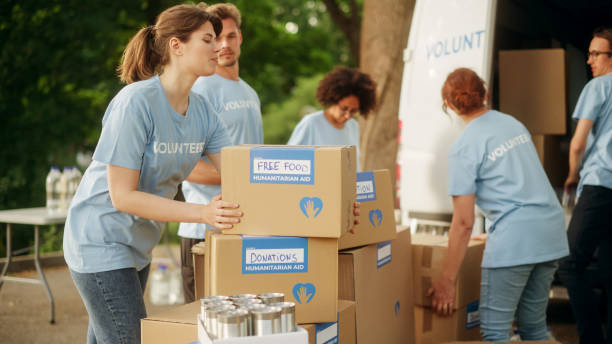Food pantries play a crucial role in addressing food insecurity, providing essential support to families and individuals in need.
To sustain and enhance their operations, many food pantries rely on grants, which are financial awards provided by government entities, foundations, corporations, and other organizations. These grants are pivotal in enabling food pantries to purchase food, cover operational costs, and sometimes expand their services to reach more people in need. Let’s delve into the world of grants for food pantries, highlighting their importance, types, sources, and tips for securing them.
The Importance of Grants for Food Pantries
Grants for food pantries are more than just financial assistance; they are lifelines that ensure these vital community resources can continue to serve those in need. With the help of grants, food pantries can:
- Purchase food in bulk, often at reduced rates, to ensure a steady supply of nutritious options for their clients.
- Cover operational expenses, such as utilities, rent, transportation, and equipment necessary for food storage and distribution.
- Implement programs that address specific community needs, such as nutritional education, cooking classes, or special diets for individuals with health issues.
- Expand their reach by setting up mobile pantries, improving facilities, or extending operating hours to serve more people.
List of Foundations Awarding Grants for Food Pantries
1. Feeding America
- Focus: As the nation’s largest domestic hunger-relief organization, Feeding America supports a network of food banks, pantries, and meal programs.
- Grant Opportunities: Offers various grants aimed at improving food security, including infrastructure grants for food storage and distribution, and program grants to address specific community needs.
2. The Walmart Foundation
- Focus: The Walmart Foundation provides grants to organizations working on the front lines of hunger relief, with a special emphasis on innovative distribution methods and nutritional education programs.
- Grant Opportunities: Local, state, and national grants are available, focusing on operational support, capacity building, and program development.
3. The Ford Foundation
- Focus: While not exclusively focused on food insecurity, the Ford Foundation supports initiatives that tackle poverty and promote social justice, which includes access to nutritious food.
- Grant Opportunities: Grants are available for strategic projects that address the root causes of food insecurity and promote sustainable solutions.
4. The Rockefeller Foundation
- Focus: This foundation focuses on building resilience and inclusive economies, with sustainable food systems as a key area of interest.
- Grant Opportunities: Supports innovative approaches to reduce food waste, improve access to nutritious food, and enhance food distribution channels.
5. The Robert Wood Johnson Foundation
- Focus: Prioritizes health, including ensuring all communities have access to healthy foods.
- Grant Opportunities: Offers funding for programs that combine hunger relief with health and wellness initiatives, particularly in underserved communities.
6. The Kellogg Foundation
- Focus: Committed to supporting children, families, and communities in overcoming poverty, including ensuring access to nutritious food.
- Grant Opportunities: Funds projects that address food security within the broader context of economic and community development.
7. The Kresge Foundation
- Focus: Works to expand opportunities in America’s cities, including access to healthy food for low-income individuals.
- Grant Opportunities: Provides grants for programs that integrate food security with community health and economic development.
8. The Hearst Foundations
- Focus: Supports health, education, culture, and social service programs, including those addressing hunger and food access.
- Grant Opportunities: Provides funding for programs that offer direct services to low-income populations, including food pantries and emergency food programs.
9. The John D. and Catherine T. MacArthur Foundation
- Focus: Known for its support of creative and effective organizations, it invests in solutions to critical social issues, which can include food insecurity.
- Grant Opportunities: Offers grants for innovative projects that address systemic problems, including sustainable food systems and access to nutritious food.
10. The Annie E. Casey Foundation
- Focus: Dedicated to developing a brighter future for children at risk of poor educational, economic, social, and health outcomes, including initiatives to ensure access to healthy food.
- Grant Opportunities: Supports community-based efforts to improve food security among families and children.
11. The Mott Foundation
- Focus: Works to support efforts that promote a just, equitable, and sustainable society, including food security initiatives.
- Grant Opportunities: Funds projects that enhance community access to fresh, locally grown food, and support sustainable agriculture practices.
12. The Howard G. Buffett Foundation
- Focus: Concentrates on improving the standard of living and quality of life for the world’s most impoverished and marginalized populations, with a strong emphasis on food security.
- Grant Opportunities: Provides support for innovative programs aimed at enhancing food production, distribution, and access.
13. The Laura and John Arnold Foundation
- Focus: Aims to improve the lives of individuals by strengthening social, governmental, and economic systems. Its interests include food insecurity as part of broader welfare initiatives.
- Grant Opportunities: Funds evidence-based programs that can significantly impact food access and nutrition.
14. The Michael & Susan Dell Foundation
- Focus: Dedicated to transforming the lives of children living in urban poverty through improving their education, health, and family economic stability, including access to nutritious food.
- Grant Opportunities: Invests in programs that address the root causes of food insecurity and promote healthy lifestyles for children and families.
15. The Pritzker Traubert Foundation
- Focus: Seeks to foster healthier, more vibrant communities in Chicago by addressing challenges in health and wellness, which includes food access.
- Grant Opportunities: Supports local initiatives that aim to make fresh, healthy food accessible to all residents.
16. The Bill & Melinda Gates Foundation
- Focus: While globally known for its work in health and development, the foundation also addresses domestic issues such as poverty and access to nutritious food.
- Grant Opportunities: Offers funding for innovative projects that increase access to agricultural resources, improve nutrition, and ensure food security.
17. The Omidyar Network
- Focus: Invests in entrepreneurial efforts to catalyze economic and social change, including sustainable food systems and nutrition.
- Grant Opportunities: Supports scalable solutions that enhance food security and access to healthy diets.
18. The W.K. Kellogg Foundation
- Focus: Concentrates on children, families, and communities to ensure all children have access to education, health, and well-being, including food security.
- Grant Opportunities: Provides grants for initiatives that support community food systems and access to affordable, nutritious food.
19. The Cargill Foundation
- Focus: Works to improve global food security and sustainability, with efforts extending to local communities where it supports programs to address hunger and nutritional needs.
- Grant Opportunities: Offers grants to organizations working on innovative solutions to improve food security and nutrition education.
20. The PepsiCo Foundation
- Focus: Committed to fostering a more sustainable food system, the foundation supports initiatives that increase access to nutritious foods and improve food security.
- Grant Opportunities: Funds programs that work towards hunger relief, improved nutrition, and sustainable agriculture practices.
When applying for grants from these foundations, it’s crucial to focus on creating a compelling narrative that highlights your food pantry’s impact on the community, your unique approach to addressing food insecurity, and how the grant will help you achieve your objectives. Tailoring your application to each foundation’s specific interests and requirements will increase your chances of success. Remember, beyond financial support, these grants represent a partnership aimed at creating a healthier, more equitable society where access to nutritious food is a reality for everyone.
How to Apply for Grants for Food Pantries
Step 1: Research and Identify Potential Grants
- Start with a Strategy: Begin by clearly defining your pantry’s needs, goals, and the specific projects or operational areas you seek funding for. This clarity will help you identify grants that align with your objectives.
- Use Diverse Sources: Explore a variety of sources to find grants, including government databases, foundations, corporate sponsors, and local community organizations. Don’t overlook niche foundations or grants focused on specific aspects of food insecurity.
- Evaluate Fit and Feasibility: Assess each grant’s focus, eligibility criteria, and application requirements. Prioritize opportunities where your pantry’s mission and the grant’s objectives closely align.
Step 2: Understand Each Grant’s Requirements
- Careful Review: Thoroughly read the grant guidelines and requirements. Understanding the funder’s priorities and how they evaluate applications is crucial for a successful proposal.
- Eligibility: Make sure your food pantry meets all eligibility criteria before investing time in an application. If in doubt, contact the grantor for clarification.
Step 3: Prepare Your Application
- Gather Necessary Information: This includes your pantry’s legal status (e.g., 501(c)(3) documentation), financial statements, operational data, and evidence of impact.
- Develop a Strong Proposal: Your proposal should clearly articulate the problem your pantry addresses, the specific objectives of your project, and how the grant funds will be used. Include details about your community’s needs, your pantry’s capacity to meet those needs, and the expected outcomes of your project.
- Budget Preparation: Prepare a detailed budget that aligns with your project plan. Be transparent and realistic about costs, and explain how each expense contributes to your project’s goals.
Step 4: Highlight Your Impact
- Data and Stories: Use both quantitative data and compelling stories to illustrate your pantry’s impact. Show how your work addresses a critical need and contributes to the community’s well-being.
- Partnerships and Support: Mention any partnerships with local organizations, community groups, or businesses that enhance your pantry’s effectiveness. Support from other stakeholders can strengthen your application.
Step 5: Write and Review Your Application
- Follow Guidelines: Adhere strictly to the grantor’s formatting and submission guidelines. Use clear, concise language and avoid jargon.
- Review and Revise: Have someone familiar with grant writing—or unfamiliar with your project—review your application. Fresh eyes can catch errors and suggest improvements to clarify your message.
Step 6: Submit Your Application
- Pay Attention to Deadlines: Ensure you submit your application well before the deadline to avoid any last-minute issues.
- Keep Records: Maintain copies of your application and all correspondence for your records.
Step 7: Follow Up and Maintain Communication
- Acknowledgement: Send a thank-you note to acknowledge the receipt of your application if the grantor has provided any personal communication.
- Be Available for Questions: Be responsive to any follow-up inquiries from the grantor. They may request additional information or clarifications.
- Report Back: If awarded a grant, adhere strictly to reporting requirements, sharing both successes and challenges. Transparent reporting builds trust and can lead to future support.
Step 8: Learn from the Process
- Reflect on Feedback: Whether your application is successful or not, seek feedback from the grantor. This insight can be invaluable for future applications.
- Adjust Strategies: Use what you learn to refine your approach to future grant applications. Continuous improvement will increase your chances of success.
Securing a grant requires diligence, patience, and attention to detail. By following these steps, food pantries can not only enhance their grant application skills but also deepen their understanding of how to effectively communicate their mission and needs. The process of applying for grants, while challenging, offers a rewarding opportunity to forge new partnerships and secure the resources necessary to make a significant impact in the fight against hunger.
Tips for Writing a Successful Grant Proposal for Grants for Food Pantries
1. Understand the Grantor’s Objectives
- Align with Their Mission: Begin by thoroughly researching the potential grantor’s mission and funding priorities. Your proposal should clearly demonstrate how your food pantry’s project aligns with their goals.
- Speak Their Language: Use terminology and phrases that resonate with the grantor’s stated objectives. This alignment shows that your pantry is a suitable partner for their mission.
2. Clearly Define Your Need
- Identify the Problem: Articulate the specific problem your food pantry addresses. Use local statistics, stories, and data to illustrate the extent of food insecurity in your community.
- Explain Your Solution: Detail how your pantry’s services provide a solution to the identified problem. Highlight your unique approach and how it fills gaps in existing services.
3. Outline Your Objectives and Goals
- Be Specific: Define clear, measurable objectives for what the grant will help you achieve. Goals should be Specific, Measurable, Achievable, Relevant, and Time-bound (SMART).
- Demonstrate Impact: Explain how achieving these objectives will impact your community. Use potential success stories or data projections to paint a picture of the future.
4. Detail Your Project Plan
- Activities and Timeline: Describe the activities that will take place to meet your objectives, along with a realistic timeline. A clear plan shows the grantor that your pantry is organized and ready to implement the project.
- Staff and Resources: Mention the staff, volunteers, and resources that will be involved. Highlighting the expertise and dedication of your team can reassure funders of your project’s feasibility.
5. Present a Detailed Budget
- Justify Expenses: Provide a detailed budget that outlines how the grant money will be used. Each expense should be clearly justified in relation to your project goals.
- Transparency and Realism: Be transparent and realistic with your budgeting. Overestimating costs can undermine your credibility, while underestimating can hinder your project’s success.
6. Demonstrate Organizational Capacity
- Showcase Past Success: Share examples of your pantry’s previous successes, especially those relevant to the proposed project. This history can build confidence in your ability to deliver results.
- Financial Health: Include information on your organization’s financial stability and other funding sources. Diversified funding sources can demonstrate resilience and capacity for sustainability.
7. Include Supporting Materials
- Letters of Support: Letters from community leaders, partners, and beneficiaries can strengthen your proposal by showcasing community backing and the broader impact of your work.
- Documentation: Provide any required documentation, such as 501(c)(3) status, financial audits, and annual reports, to fulfill the grantor’s application requirements.
8. Write Clearly and Concisely
- Avoid Jargon: Use clear, straightforward language that can be understood by someone not familiar with your work or the nuances of food security.
- Be Persuasive, Yet Honest: Your proposal should persuade the reader of the value and necessity of your project, but always remain grounded in realistic assessments and expectations.
9. Proofread and Review
- Attention to Detail: Carefully proofread your proposal to eliminate any spelling, grammar, or factual errors. Mistakes can detract from the professionalism of your submission.
- Seek Feedback: Before submission, have someone outside of your organization review the proposal. Fresh eyes can catch overlooked errors and suggest improvements to clarify your message.
10. Follow Submission Guidelines
- Adhere to Instructions: Follow the grantor’s submission guidelines meticulously, including format, length, and submission method. Deviating from these instructions can result in your application being disregarded.
Crafting a successful grant proposal requires time, effort, and a strategic approach. By following these tips, food pantries can increase their chances of securing the grants they need to continue their vital work in the community. Remember, each grant proposal is an opportunity to tell your story, demonstrate your impact, and forge new partnerships in the fight against hunger.
Conclusion:
Grants for food pantries represent a critical lifeline in the battle against hunger and food insecurity. As these pantries strive to meet the ever-growing needs of their communities, the support provided by grants from various foundations, government programs, and corporate initiatives becomes indispensable. Securing such funding is not just about financial assistance; it’s about building a sustainable foundation that allows food pantries to innovate, expand, and deepen their impact.

Advertisements
The journey to secure grants involves understanding the landscape of potential funders, aligning with their goals, and crafting compelling proposals that highlight the unique contributions of your food pantry to community well-being. It’s a process that demands diligence, clarity, and a deep commitment to the mission of eradicating hunger.
Yet, the effort and resources invested in pursuing grants can yield significant rewards. Beyond the immediate benefit of funding, the process of applying for grants encourages food pantries to refine their objectives, articulate their impact, and engage with a broader network of allies in the fight against food insecurity. It’s an opportunity for growth, learning, and community engagement that extends far beyond the monetary value of the grants themselves.
As food pantries continue to navigate the challenges and opportunities of securing funding, it’s essential to remember the ultimate goal: to ensure that every individual and family has access to nutritious food. The pursuit of grants is a testament to the resilience, creativity, and dedication of those who operate and support food pantries. Together, through collaboration and shared commitment, we can build a future where hunger is no longer a barrier to health, opportunity, and potential.
In the end, grants for food pantries are more than just financial support—they are a manifestation of hope, solidarity, and the collective belief in a more equitable and food-secure world.
To further enhance your grant writing skills and stay on top of these trends, consider diving into some insightful literature.
Here are a few recommended books:
- The Ultimate Guide to Federal Grant Applications: Techniques for Success – This book is a must-read for anyone looking to navigate the complex world of federal grant applications. It offers practical techniques, insider tips, and a comprehensive understanding of what it takes to create successful federal grant applications.
- Advanced Grant Writing for Nonprofits : Focuses on sophisticated techniques for experienced grant writers. It delves into complex aspects of proposal development, offering strategies for dealing with competitive grant environments and large funding bodies.
- Mastering Grant Writing: A Nonprofit’s Guide to Effective Proposal Development and Submission: This book serves as a comprehensive guide, covering the entire process of grant writing. It includes tips on understanding funders’ perspectives, crafting compelling narratives, and the nuances of proposal submission.
- Becoming the Grant Guru: Freelancer’s Guide to Success : Tailored for freelance grant writers, this book provides insights into building a successful career in grant writing. It includes strategies for finding clients, managing projects, and maximizing the impact of grant proposals.
- The Small Business’s Guide to Winning Grants : This resource is particularly useful for small businesses looking to secure grants. It offers practical advice on identifying suitable grant opportunities, understanding the requirements of small business grants, and crafting winning proposals.
- Grant Readiness Guide: Preparing to Triumph in Funding Opportunities : A comprehensive resource for organizations at various stages of grant preparedness. It provides a roadmap for developing organizational capacity, aligning projects with funders’ goals, and creating compelling applications.
- Her Capital: Unlocking Women’s Small Business Grants: Specifically designed for women entrepreneurs, this book offers guidance on navigating the landscape of small business grants for women. It includes insights into grant sources, application strategies, and tips for leveraging grants to grow a business.
Join our email list now for exclusive grant-writing tips and unique grant opportunities delivered straight to your inbox. Click here to Subscribe. Don’t miss out!






